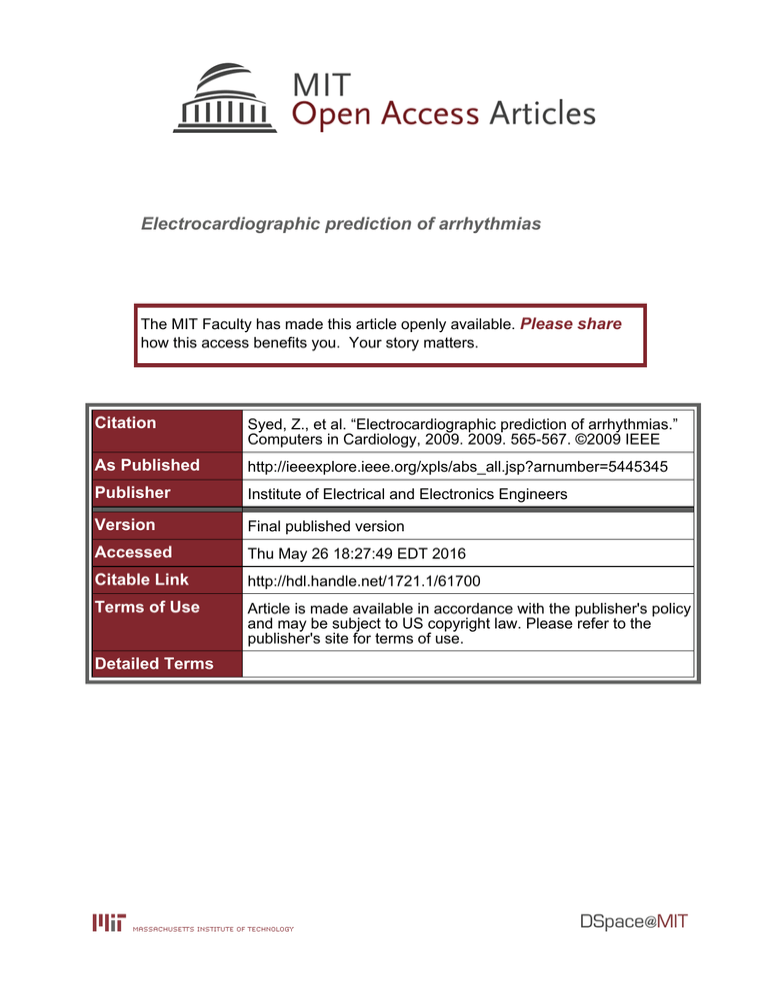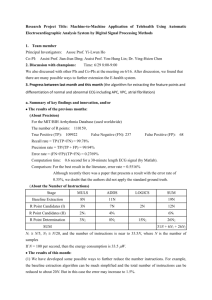Electrocardiographic prediction of arrhythmias Please share
advertisement

Electrocardiographic prediction of arrhythmias The MIT Faculty has made this article openly available. Please share how this access benefits you. Your story matters. Citation Syed, Z., et al. “Electrocardiographic prediction of arrhythmias.” Computers in Cardiology, 2009. 2009. 565-567. ©2009 IEEE As Published http://ieeexplore.ieee.org/xpls/abs_all.jsp?arnumber=5445345 Publisher Institute of Electrical and Electronics Engineers Version Final published version Accessed Thu May 26 18:27:49 EDT 2016 Citable Link http://hdl.handle.net/1721.1/61700 Terms of Use Article is made available in accordance with the publisher's policy and may be subject to US copyright law. Please refer to the publisher's site for terms of use. Detailed Terms Electrocardiographic Prediction of Arrhythmias Z Syed1, BM Scirica2, CM Stultz3, JV Guttag3 1 2 University of Michigan, Ann Arbor, MI, USA TIMI Study Group, Brigham and Women's Hospital, Boston, MA, USA 3 Massachusetts Institute of Technology, Cambridge, MA, USA significant arrhythmias observed subsequently during patient monitoring. Abstract Information in electrocardiographic (ECG) signals is widely believed to have value in the short-term prediction of arrhythmias. This study evaluates the use of morphologic variability (MV), a recently proposed metric measuring subtle variability in the shape of ECG signals over long periods, to risk stratify patients for arrhythmia following non-ST-elevation acute coronary syndrome (NSTEACS). We assessed the relationship between MV and the composite occurrence of ventricular tachycardia and cardiac pause (150 events) in 2302 patients admitted post-NSTEACS. On univariate analysis, high MV was strongly associated with the short-term occurrence of arrhythmias (HR 2.02; 95% CI 1.42-2.87; p<0.001). The relationship between MV and arrhythmias was consistent even after adjusting for other risk variables (adjusted HR 2.04; 95% CI 1.37 - 3.03; p<0.001). Our results suggest that MV may be a clinically useful tool for identifying patients at an increased short-term risk of serious arrhythmias in the setting of NSTEACS. 1. 2. The process of measuring MV starts out by quantifying the differences in morphology between every pair of consecutively occurring beats in the ECG signal. This is done using a variant of dynamic time-warping (DTW) [5] to align samples that correspond to the same kind of underlying physiological activity. More precisely, given two beats, x1 and x2, of length l1 and l2 respectively, DTW produces the optimal alignment of the two sequences by first constructing an l1-by-l2 distance matrix d. Each entry (i,j) in this matrix d represents the square of the difference between samples x1[i] and x2[j]. A particular alignment then corresponds to a path, l through the distance matrix of the form: ϕ (k ) = ϕ 1 (k ),ϕ 2 (k ) , 1 ≤ k ≤ K (1) ( ) where l1 and l2 represent row and column indices into the distance matrix, and K is the alignment length. The optimal alignment produced by DTW minimizes the overall cost: C ( x1 , x 2 ) = min Cϕ ( x1 , x 2 ) (2) Introduction ϕ We recently proposed morphologic variability (MV) as a measure of subtle changes in the shape of the electrocardiogram (ECG) signal over long periods of time [1]. MV is motivated by the belief that persistent lowamplitude changes in ECG morphology might be indicative of electrochemical abnormalities within the myocardium that are potentially proarrhythmic. Recent studies in multiple post-non-ST-elevation acute coronary syndrome (NSTEACS) cohorts have shown that MV has value in risk stratifying patients for cardiovascular death [2-4]. In particular, high MV is associated with an increased risk of cardiovascular death over both a 90 and 360 day period following NSTEACS. In this paper, we evaluate the clinical utility of MV to identify patients at increased short-term risk of cardiac arrhythmias. We use ECG data from post-NSTEACS patients and study the association between increased MV measured during the first 24 hours of hospitalization and ISSN 0276−6574 Methods where Cϕ is the total cost of the alignment path l and is defined as: K Cϕ ( x1 , x 2 ) = ∑ d (x1 [ϕ 1 (k )], x 2 [ϕ 2 (k )]) (3) k =1 The search for the optimal path is carried out in an efficient manner using dynamic programming. The final energy difference between the two beats x1 and x2, is given by the cost of their optimal alignment, and depends on both the amplitude differences between the two signals, as well as the length K of the alignment (which increases if the two beats differ in their timing characteristics). In this way, the technique described here measures changes in morphology resulting from both amplitude and timing differences between the two beats. The process described above transforms the original ECG signal from a sequence of beats to a sequence of 565 Computers in Cardiology 2009;36:565−567. associated with an increased short-term risk of arrhythmia (HR 2.02; 95% CI 1.42-2.87; p<0.001). This result was consistent even after adjusting for both the TIMI risk score and the best performing HRV measure (adjusted HR 2.04; 95% CI 1.37-3.03; p<0.001). Table 1 presents the complete results of multvariate analysis. While we chose to combine VT and CP into a composite endpoint to ensure that our study had sufficient statistical power, we also measured the association between MV and these individual arrhythmias separately. Table 2 presents the results of this analysis. For both VT and CP, high MV was associated with an increased shortterm risk for each of these endpoints. The hazard ratios in both cases were identical. energy differences. This new signal, comprising pairwise, time-aligned energy differences between beats, is then smoothed using a median filer of length 8. We call the resulting times series the morphologic distance (MD) for the patient. We estimate the power spectral density of the MD time-series using the Lomb-Scargle periodogram [6], which is well-suited to measure the spectral content of an irregularly sampled signal by taking into account both the signal value and the time of each sample. The morphologic variability (MV) for a patient is then defined as the energy in the MD time-series power spectral density between 0.30-0.55 Hz [2,3]. 3. Results Table 1: Multivariate association between risk variables and the composite endpoint of arrhythmia (n=2303, events=150) Parameter Hazard Ratio (P-value) We calculated MV within 48 hours of ACS for 2302 placebo patients in the MERLIN trial [7]. MV was measured on the first 24 hours of available ECG data. Patients were dichotomized into high (MV>52.5) and low (MV<52.5) risk groups consistent with earlier studies [2,3]. We defined the endpoint of arrhythmia as the composite occurrence of ventricular tachycardia (VT) > 8 beats or cardiac pause (CP) > 3 seconds after the first 24 hours of ECG monitoring (the median duration of ECG monitoring for patients in the MERLIN trial was 6.8 days). The decision to focus only on arrhythmias occurring after the first 24 hours of ECG monitoring was to ensure that the ECG data used to measure MV (i.e., for prediction) and the ECG data used to measure future endpoints (i.e., for assessment) were distinct. Each arrhythmia was verified by a human expert looking at the ECG tracings. A total of 150 composite events were observed in the study population. We evaluated MV in both univariate and multivariate models. Our multivariate model was constructed using MV, the TIMI risk score for NSTEACS (TRS), and heart rate variability (HRV). TRS [8] was calculated by summing up the following predictor variables (1=yes, 0=no): age 65 years or older, at least 3 risk factors for coronary artery disease, prior coronary stenosis of 50% or more, ST-segment deviation on ECG at presentation, at least 2 anginal events in prior 24 hours, use of aspirin in prior 7 days, and elevated serum cardiac markers. The TIMI risk score was categorized as low risk (0-2), moderate risk (3-4) and high risk (5-7) [7]. For HRV, we considered the SDNN, SDANN, ASDNN, RMSSD, HRVI, pNN50 and LF/HF metrics that were proposed by the Task Force of the European Society of Cardiology and the North American Society of Pacing and Electrophysiology [9]. To avoid issues of collinearity, only the best performing (i.e., LF/HF) metric was included in the multivariate model. On univariate analysis, high MV was strongly MV TRS Moderate (3-4) High (5-7) HRV 2.04 (<0.001) 1.03 (0.886) 1.20 (0.467) 0.95 (0.806) Table 2: Univariate association between MV and specific arrhythmias (n=2303) Hazard Ratio for Arrhythmia # of Events MV (P-value) VT > 8 beats CP > 3 sec 4. 108 46 1.95 (0.001) 1.95 (0.033) Discussion and conclusions In this paper, we evaluated the clinical utility of MV, a recently proposed metric that quantifies subtle variability in the shape of the ECG signal over long periods of time, for short-term risk stratification. MV is intended to measure electrochemical abnormalities within the myocardium that are potentially proarrhythmic. To assess the relationship between high MV and an increased risk of arrhythmia, we used ECG data collected from postNSTEACS patients and related MV measured during the first 24 hours of monitoring with the occurrence of VT and CP during subsequent monitoring. We found that high MV was strongly associated with an increased risk of both VT and CP. These findings were consistent even after adjusting for HRV and the TIMI risk score (which captures many important clinical risk variables). The results reported here strongly suggest that MV may have value in identifying patients in a proarrhythmic state following NSTEACS. The use of MV for short-term 566 risk stratification post-NSTEACS may therefore help clinicians choose specific treatments that are appropriate for each patient's individual risk. Acknowledgements This work was supported by the Center for Integration of Medicine and Innovative Technology (CIMIT), the Harvard-MIT Division of Health Sciences and Technology (HST), and the Industrial Technology Research Institute (ITRI). The MERLIN trial was supported by CV Therapeutics. References [1] Syed Z, Stultz C, Scirica B, Cannon C, Attia K, Stebletsova I, et al. Morphological variability: a new electrocardiographic technique for risk stratification after NSTEACS. Circulation. 2007;116:II_634. [2] Syed Z, Scirica B, Mohanavelu S, Sung P, Michelson E, Cannon C, et al. Relation of death within 90 days of nonST-elevation acute coronary syndromes to variability in electrocardiographic morphology. Am J Cardiol. 2009;103:307-11. [3] Syed Z, Sung P, Scirica B, Morrow D, Stultz C, Guttag J. Spectral energy of morphologic differences to predict death. Cardiovasc Eng. 2009;9:18-26. [4] Syed Z, Scirica B, Stultz C, Guttag J. Risk-stratification following acute coronary syndomres using a novel electrocardiographic technique to measure variability in morphology. Comput Cardiol. 2008;13-16. [5] Rabiner L. Considerations in dynamic time-warping algorithms for discrete word recognition. IEEE Trans Sig Proc. 1978;26:575-82. [6] Lomb N. Least-squares frequency analysis of unequally spaced data. Astrophys Space Sci. 1976;39:447-62. [7] Morrow D, Scirica B, Prokopczuk E, Murphy S, Budaj A, Varshavsky S, et al. Effects of ranolazine on recurrent cardiovascular events in patients with non-ST-elevation acute coronary syndrome: The MERLIN-TIMI 36 randomized trial. JAMA. 2007;297:1775-83. [8] Antman E, Cohen M, Bernink P, McCabe C, Horacek T, Papuchis G, et al. The TIMI risk score for unstable angina/non-ST elevation MI: a method for prognostication and therapeutic decision making. JAMA. 2000;284:835842. [9] Malik M, Heart rate variability: standards of measurement, physiological interpretation, and clinical use. Circulation. 1996;93:1043-65. Address for correspondence Zeeshan Syed zhs@eecs.umich.edu 567





